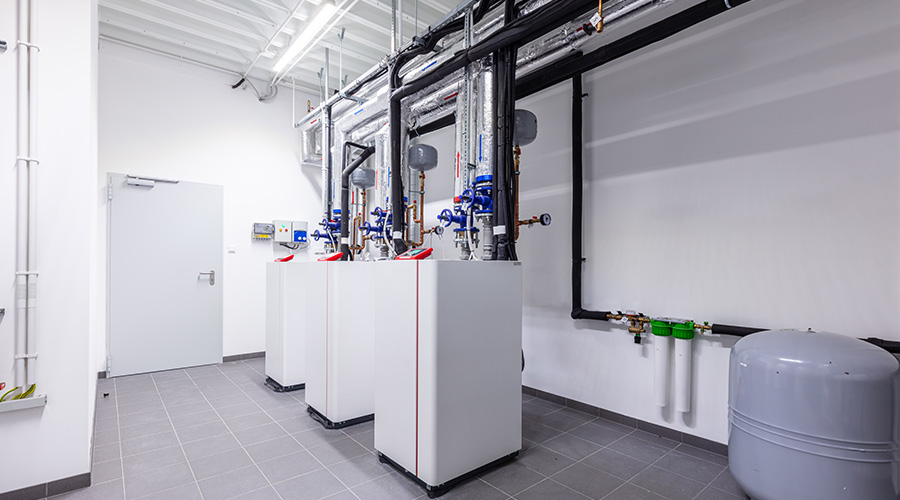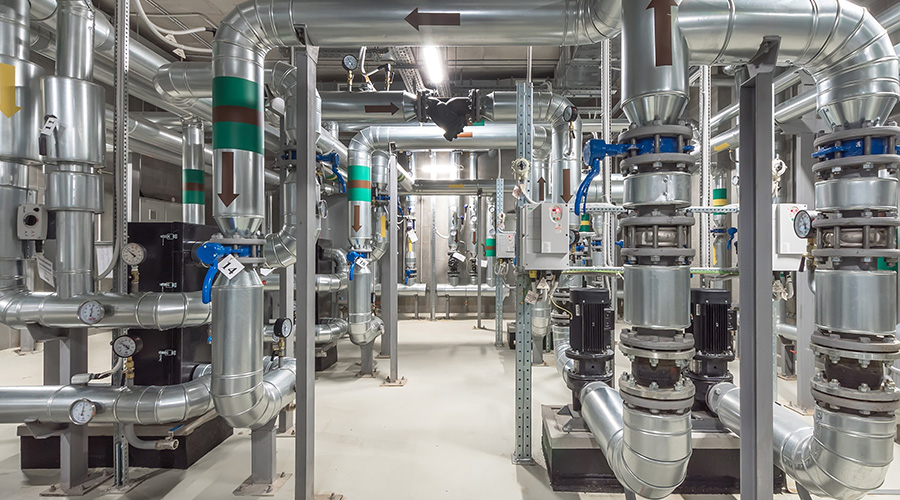Sooner and Later, Rightsizing Pays Off
Many HVAC systems are substantially oversized, says EPA’s Energy Star Buildings program. Matching the systems to actual loads could minimize initial and operating costs
Imagine that the weather suddenly changes, dropping 50 degrees with strong stormy winds, and someone who needs to venture outdoors puts on a warm wool coat that happens to be 50 percent bigger than the size that person should wear. The consequences are obvious: That hardy soul will not be as cold as he or she would be without a coat, but the poor person won’t be warm either. The winds stream up the sleeves, whipping the coat’s bottom flaps open to blow freezing air straight up to the person’s chest.
While few people run around wearing coats that are far too big, it’s clear that even the warmest of coats will not perform optimally if it’s the wrong size. Yet facility executives often expect optimum performance from HVAC equipment under similar conditions.
When the Environmental Protection Agency began studying the energy performance of the whole building, it found that HVAC equipment was often like that good coat that was the wrong size. One consequence was that even energy-efficient individual components did not guarantee optimum performance by the total building.
“When we began rating the whole building in terms of energy performance, we found that some buildings had good technologies in them, but scored poorly,” says Jean Lupinacci, chief of the Energy Star commercial and industrial markets at EPA.
For example, efficient chillers operating at part-load conditions were not saving as much energy as they could have been.
“There are several problems with oversizing,” says Lupinacci. “First is the capital outlay for the larger chillers. That’s wasted capital that could be put back into something else. The second problem is that energy expenses are higher than they need to be. The third problem is that if a system is oversized then it isn’t taking moisture out of the air properly. So, in addition to the comfort of the people inside the building, you also may have mold problems.”
Several years ago, EPA funded a study on fan system oversizing. Researchers flew to Energy Star partner sites across the country on peak cooling days and took on-site measurements. What the study found, says Lupinacci, was that “60 percent of the buildings, mostly office buildings, had systems that were 60 percent larger than they needed to be.”
In another study, two state-of-the-art chillers rated well in efficiency testing. However, their real-world performance was equivalent to a 15-year-old chiller that was the right size for the facility because they were operating below 25 percent of their designed cooling load most of the time.
“Without other strategies for optimizing their chillers, this building was no better off than an older building in terms of its overall energy use,” says Lupinacci.
Boilers also suffer from oversizing. Short cycling boilers increases the system’s standby energy losses and causes thermal stresses that reduce the life of the equipment.
While Energy Star has not done detailed cost estimations for oversizing, the agency has looked at the lack of energy-saving component integration and found that when HVAC and other systems are not integrated for energy savings, the difference can be as much as $2 per square foot.
If a reasonable margin of safety for HVAC design is 10 to 15 percent above projected loads, how do so many systems get sized incorrectly? One problem is that facility executives and mechanical engineers don’t look closely enough at the question of sizing. Building codes and guidance standards from associations set minimum parameters, but true sizing requires intimate and detailed knowledge of the building, its intended use and many other elements.
Understanding Actual Loads
“Properly sizing HVAC systems is a complex task requiring a solid understanding of all variables affecting building loads,” says Patrick I. Branch, president of engineering for Astorino. There are four major types of loads placed on a building’s HVAC system. They are transmission, solar (an external load placed on the building envelope), ventilation and internal loads, such as the heat generated by computers, lighting systems and people.
“Virtually all design, construction and facility operational decisions impact these variables,” says Branch. “As projects evolve, the impact of these decisions must be considered relative to the HVAC system. Many times, decisions are made to ‘save’ the cost of or time required for proper design, which almost always results in conservative rules of thumb being applied and systems being oversized.”
Getting It Right
The way to avoid oversizing the HVAC system is to use integrated, or whole-building, design by identifying and modeling the facility’s real needs for heating, ventilating and air conditioning. That means moving away from building codes or rules of thumb as the basis for specifications.
For example, using a conservative rule of thumb, chillers might be specified by the following assumptions: Every room is fully occupied with all lights, computers and other equipment turned on and no shades pulled for every minute of the hottest day expected in the area. Conversely, the boilers might be specified for the coldest possible day, assuming the few people working that day are doing paperwork using natural daylight, with no coverings on windows.
Both scenarios rarely, if ever, happen. Instead, they often provide excessive “margins of safety” that is often rationalized because it rarely results in a large cost increase, says Adrian Tuluca, principal at Steven Winter Associates. “Because oversizing has been a common practice for so long, building owners do not notice those margins of safety as being unusual.”
To size HVAC systems to meet actual loads requires more time and sophistication from the mechanical engineer and facility executive.
When a whole building analysis of the HVAC system is completed, the engineers conducting the analysis will allow a 10 to 15 percent margin above the actual calculations. That amount helps compensate for changes that may happen during the actual use of the building. So, if the numbers and load modeling data indicate a 600-ton chilling plant is needed, most engineers will specify 700 tons to make sure any loads not anticipated can be covered by the system. But, when these analyses are done on existing buildings, experts often find loads are 20 to 30 percent below the mechanical engineer’s calculations, even after the 10 to 15 percent margin of safety is added. In other words, the chiller plant may well be 1,000 tons — with a margin of safety of 30 to 40 percent over need — rather than 700 tons.
One cause for oversizing is a lack of communication, says Tuluca. “The architect and the facility executive need to tell the mechanical engineer, ‘We aren’t sure exactly what glass type we are going to use yet, but it will be energy efficient, occupy about this amount of the building envelope and in the worst case be low-e clear glass with 0.442 shading coefficient. Don’t assume any more sun than that.’”
Similarly, the mechanical engineer needs to know that the lighting in the building will be 30 percent more efficient than standard lighting systems. “Building codes allow a lot of internal load on a chiller for lighting,” says Tuluca. “If you want the engineer to design the HVAC system for the building, then he or she needs to be given direction. Otherwise, you are going to have an HVAC system that’s designed to meet the building code’s standards. And that almost guarantees the building will have a system that is significantly oversized.”
Tuluca says there may be some resistance to whole building thinking. Mechanical engineers may argue they have always designed HVAC systems their way and it’s worked.
But Tuluca suggests the truer statement would be: “We’ve always designed HVAC systems that way and we’ve always gotten away with it.”
Pay Now Or Pay Later
Additional attention to detail will cost a little more during the design phase, because of the additional engineering fees associated with detailed building modeling. But the resulting HVAC system may well be smaller, reducing first costs, and it definitely will operate better if it is used close to its full potential. In addition, the mold and moisture issues associated with chillers operating at part-load conditions are eliminated when proper dehumidification can occur. There is less wear and tear on boiler elements that don’t cycle up and down rapidly. Fans are not cycled on and off constantly because the loads are handled more evenly. Heat or alternative dehumidification is not needed to control space humidity issues caused by oversized air-conditioning equipment. Quite often, these elements result in a rapid payback of those additional upfront engineering fees.
Even for facilities where temperature and humidity are major issues and the margin of safety is paramount — mission-critical spaces and medical centers, for instance — there are options for matching HVAC technology to load requirements. One popular method involves installing multiple small chillers or boilers that can be cycled on or remain as backup units depending on real load conditions. Another approach is to use variable speed drives. Another technology gaining increased attention is thermal storage, which offers energy savings now and can be an insurance policy or additional margin of safety.
A good example of the way thermal storage can fit into a careful HVAC design is Panda Restaurants’ headquarters in Rosemead, Calif. The building’s existing chiller plant served the 90,000-square-foot office facility and 80,000 additional square feet of conditioned warehouse. “The warehouse was nominally air conditioned,” says Dale Au, project manager for Graycon, contractor on the project. “But Panda is growing rapidly and 25 to 50 percent of that space might have to be converted into office space fairly quickly.”
Though many buildings have oversized HVAC systems, this facility’s original system was too small to meet present and near future needs. “The chiller plant was a 1978 design,” says Au. “In those days, only 5 cubic feet per minute ventilation was required. Today, we require 15 cfm.” The original 360-ton system capacity also did not compensate for additional loads now and projected loads in the future. Those calculations suggested the facility needed 450 tons of cooling. And that meant the headquarters would also need additional electrical service.
Two existing 190-ton centrifugal units were operating continuously, trying to meet the building loads. Rather than replacing both of these units, Panda is keeping one unit as a backup system and adding a 255-ton ice-making centrifugal chiller that will enable the building to meet the 450-ton cooling load by taking advantage of thermal storage. That approach does not require upgrading the electrical service.
During off-peak electricity periods, ice is made by the 255-ton chiller and stored in nine tanks. When cooling is required, the ice feeds the chilled-water air-handling units.
Currently, the 255-ton unit is handling the building’s full air-conditioning load. But Panda recently learned first hand the value of thermal storage. When the chiller went down for two days of warranty work, the building’s peak demand skyrocketed, says Au.
Initial studies showed a payback of about 3.5 years for the additional investment in thermal storage as opposed to one 450-ton centrifugal unit. Currently, the ice used in the chilled water system is supplying the building’s full cooling load, so the actual payback will be shorter than originally calculated, according to Au.
Good Operating Practices
Of course, rightsizing is only one piece of the puzzle when it comes to controlling HVAC operating costs. Consider 1900 K Street. In November 2000, Hines acquired the Washington, D.C., property. It’s a 13-story, Class A commercial office building with multiple tenants. The basic HVAC system is a floor-by-floor, chilled-water, variable-air-volume system.
“The Energy Star Building Label was earned at 1900 K Street without the implementation of new technologies or equipment, but rather because we operate the existing mechanical systems more efficiently,” says Mark Jensen, engineering manager. “More creative and efficient use of scheduling, automated control systems and maintenance practices are examples of ways we feel this was possible.”
Since achieving the award, additional new technology and equipment improvements to increase energy efficiency have also been incorporated, says Jensen. These include installing a variable frequency drive on one of the chillers and installing occupancy sensors in all exterior offices throughout the building, with all interior offices scheduled to be completed in 2004. Improved water chemistry has resulted in improved heat transfer due to cleaner surfaces.
Off To A Good Start
Although operational strategies and upgrades are clearly important, designing the HVAC system so that it is properly sized for its specific application is the starting point for efficiency. That means understanding how the building’s envelope, its lighting, its occupancy and other elements affect heating, ventilating and air-conditioning loads. That means facility executives need to understand how these elements interact with each other and the HVAC system.
Optimizing HVAC performance clearly requires that the system be designed in light of total building performance, says Lupinacci. But that won’t happen unless facility executives are educated about the value of rightsizing and the importance of whole-building design.
There’s a surprising obstacle to more efficient HVAC design: the fact that the HVAC system is a relatively small item in the total cost of construction. “During construction, the owner’s representative often is trying to keep a $50 million project on time and on budget,” Tuluca says. “They don’t want to be bothered with a $250,000 item such as the HVAC system. But when it starts costing the owner $10,000 annually because the system is not performing optimally, then management screams bloody murder.”
Related Topics:











